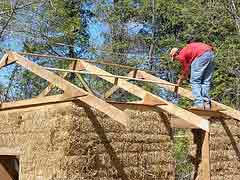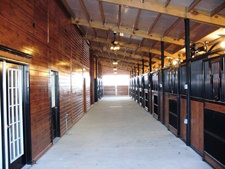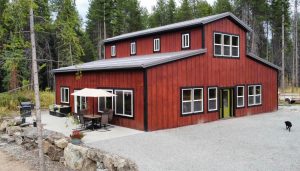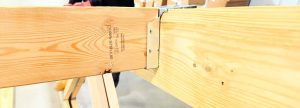And he huffed and he puffed and…
 Ok – couldn’t help myself when I thought about writing about straw houses!
Ok – couldn’t help myself when I thought about writing about straw houses!
For years I’ve been fielding inquiries from people who are interested in integrating basic pole barn design, with straw bale infills, to use as residential structures.
During a recent visit to a Home Depot in New Mexico, one of the PASAs (Pro Account Sales Associate) recommended I write a blog post about straw bale homes, using post frame construction.
To get started, I whipped out the trusty Google-machine and started searching….and searching…and searching. And found pretty much nothing. At least nothing about using the pole barn as the structural framework, lots of information out there on straw bale homes. Considering the wealth of information available, it was surprising to read how few straw bale homes exist, but that is a different story altogether.
The top advantage of using the post frame technique is it gets a roof over one’s head in a hurry and at a reasonable cost. It also allows the straw bale infill to be non-load bearing, which reduces the costs of the exterior walls (no need for structural headers as long as door and window openings are placed between columns). Most straw bale homes have very small clearspans, as trusses are not usually utilized. The pole barn framework allows for very wide spans, which eliminates the need for interior load bearing walls, and frees up space to allow for a more open design.
The most cost effective column spacing for pole building construction is typically to place them every 12 feet. This increment works out very effectively with either three or four foot bales.
Some design considerations – the one which will be most frequently overlooked is going to be deflection. A roof only “pole barn” will typically have a great deal of deflection at the eave line. Think of the posts (as a roof only building) acting as diving boards. The IBC (International Building Code) limits the deflection of members supporting exterior walls with brittle finished (like plaster of bales) to L/240.
In layperson’s terms, this would mean a nine foot tall exterior wall (which would be needed to create eight foot high ceilings), could deflect a maximum of 108”/240, or less than ½ of an inch. Do not just assume this type of deflection limitation when ordering – it is essential the company providing the building understands this to be a crucial element. In many cases, it is going to entail columns being larger in size than would otherwise be the case.
Make sure to specify the building is to be used as a residence. Residences will be Occupancy Category II and designated as Use Class R-3. Most roof only “pole barns” are Occupancy Category I and have less stringent requirements for resistance of climactic loads (wind, snow and seismic forces).
Most straw balers are well in tune with energy savings. The pole building roof structure fits well with this. Trusses can easily be designed to allow for a “raised heel”, allowing for the full thickness of insulation to be installed from wall-to-wall. The eaves should have overhangs on the low sides, which are enclosed with vented soffits to allow for an air inlet into the otherwise dead airspace in the attic. Similarly, the ridge should be vented, to allow for an exhaust point.
If using steel roofing over purlins (which will be the most cost effective), condensation needs to be controlled. Easiest is to order steel with an Integral Condensation Control factory applied.
For planning and constructing the bale portion of the project, there are a couple of highly referenced resources. Both “Serious Straw Bale” and “The Natural Building Companion” are available online and offer plenty of information. Good Luck and let us know if we can help you design your new straw bale home!










Hi! What a relief it was to find this article about using a pole barn structure for a straw bale home! My husband and I are planning on using a pre-engineered pole barn kit, and then assembling it ourselves and using straw bale for infill, but I had no idea what the deflection would need to be etc. We wanted to build a 36’x48′ shop, and permit it as a residence with the back half sectioned off as living quarters. We would then live in this for a year or two while we save and then build the main residence (straw bale as well, but not a shop, an actual house) post and beam with straw bale infill. We are also looking at designing the main home too, rather than buying pre-made plans, but if we can find plans that work that are pre-engineered, then that would be good.
Do you design and engineer straw bale homes?
Katie ~ Thank you for reading our blog. Yes, we can design and engineer a post frame building to be used with straw bales.
Have you built your house. We are strongly considering a pole building with straw bale infill and I was hoping you would have some information. Thanks.
Dan
Hi, I am so glad I found this article! I have been unsuccessfully searching the web trying to figure out if it would be possible to find post beam kit to use with straw bale. What would the proximate cost for a 24×24 kit be?
Lexa ~ The easiest way to find out is to request a quote at: https://www.hansenpolebuildings.com/freequote.htm as where you are geographically and other factors will influence price greatly.
Is it possible to use straw bales as insulation for a pole building? If so, what should one do to prevent condensation between the steel walls and the straw bales? ANy other thoughts you have on this are most welcome.
The answer to the question about using straw bales as insulation for a pole building is essentially NO. The reason is the fire hazard straw NOT covered with plaster would present. it cannot be up against the steel with nothing inbetween as there would also be a tendency to rot. And tiny animals will become a real problem. To use straw as an insulation material within a steel structure you would be better off using Light Straw Clay, which is a wet mixture poured into a mold of sorts. The way this could be done would be to build out the inside of the building as if you were going to put insulation in the spaces. Use a 4×8 sheet of plywood or any size you choose to work with. Nail the plywood up to the build-out on the inside wall that leaves a gap to pour the Light Straw Clay into. Once the infill is dry – 2-3 days should be enough time in warmer temps, pull the plywood and move to a new section. Do this floor to ceiling. It is quite a bit of work. Look up Light Straw Clay on YT – you’ll find several resources that shows this process.
Hi All,
You most certainly can insulate a pole building with straw bale. You would need a vapor barrier on the inside of the building to keep the metal from touching the straw. Concrete floors with a raised edge that will support the bales, also with a vapor barrier. tie the bale walls into existing posts, and finish interior walls like traditional straw bale house interior. Straw bales ar compressed and dont readily have enough oxygen to burn on thier own. We are preparing to build this very structure. Hope to have some video and pics to share with the community.
Hi Mathew, I’m thinking of doing exactly what you were planning on with insulating a pole barn. Do you mind letting me know where you’re at in process and how it is coming along? Thanks.